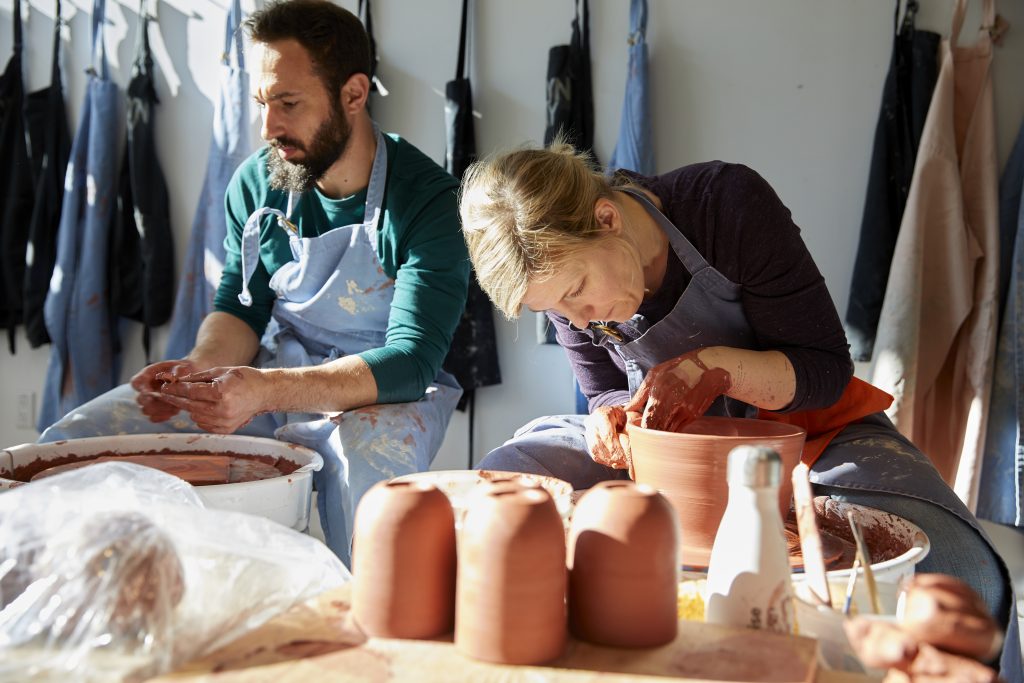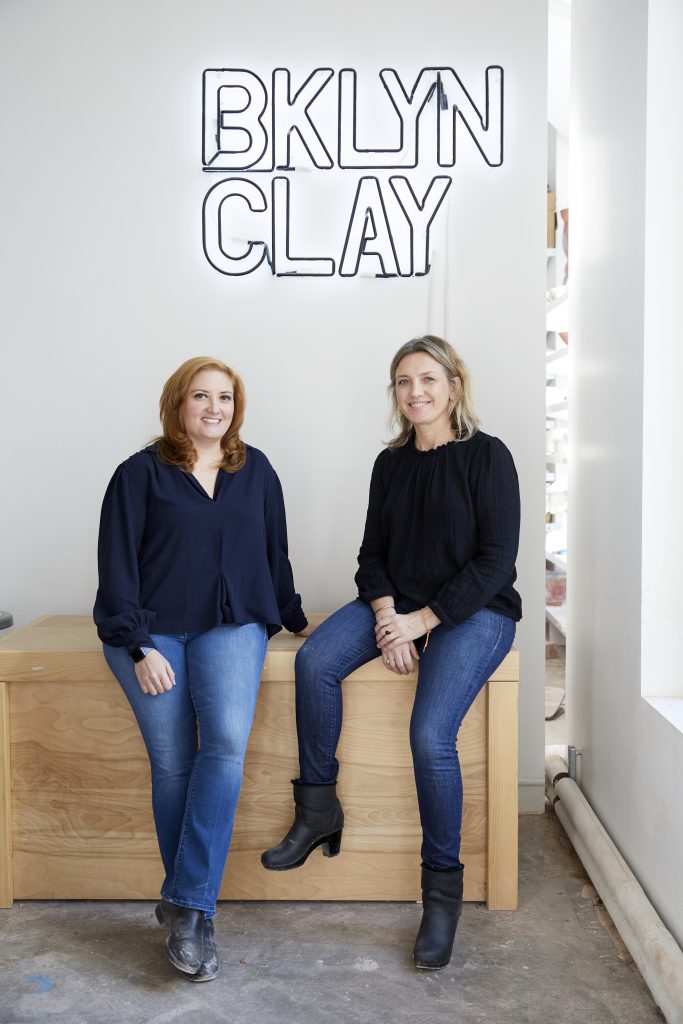
A dozen wheels punctuated with orange clothes and mats stretched out in front of a long slab of wood, like a spinning Last Supper set-up. I picked a spot at the end to avoid breaking up couples who attended together. After grabbing clay from a repurposed trash bin, I threw the clay around in my hands as I looked around the studio.
“When Jen [Waverek] founded it, the concept was to create an elevated space,” Laura Vogel, BKYLN Clay’s COO/CFO said. “It’s really hard to keep ceramics studios clean. It’s really hard to keep them clutter free. It’s hard to keep them aesthetically elevated and pleasing. I think that people really like having a clean environment to work in.”

A dozen wheels punctuated with orange clothes and mats stretched out in front of a long slab of wood, like a spinning Last Supper set-up. I picked a spot at the end to avoid breaking up couples who attended together. After grabbing clay from a repurposed trash bin, I threw the clay around in my hands as I looked around the studio.
“When Jen [Waverek] founded it, the concept was to create an elevated space,” Laura Vogel, BKYLN Clay’s COO/CFO said. “It’s really hard to keep ceramics studios clean. It’s really hard to keep them clutter free. It’s hard to keep them aesthetically elevated and pleasing. I think that people really like having a clean environment to work in.”
The white walls and cabinets with shelves full of kiln-fired mugs and bowls made the space feel like a Hollywood version of purgatory. Anything outside the beige dried clay or white walls, from the orange dish towels, the bright beanie of one member working on their own, or the two small dogs the member dog-sits sniffing the dust of the floor, commanded attention.
Once the class started, I trained my eye on the orange mat. I followed the instructor’s advice about centering the clay, throwing it hard enough to stick, and moving a sponge along the perimeter of the clay’s base to anchor and seal it for the upcoming spins. There was something almost natural or nostalgic about touching clay, about wetting it so it stays “glossy” while spinning. Maybe it’s a kindergarten playground memory of finding red clay in a sandbox and working our five-year-old fingers to dig as much of it as possible out of the ground. Maybe it’s a clay kit my friend had a few years ago where I made a little clay turtle named “Taxi”. Or maybe there’s a more primal drive beneath clay.
“It is one of the most ancient art forms,” Vogel said. “Connecting with something that has such a long history, and is literally earth, is appealing to people. Also, you have to put your phone down. You can’t do it while holding your phone. That forced separation is good for people, and people really need an excuse to do that. For ceramics, you need two hands in mud.”
While it would be easy to associate the pandemic with the increased popularity of a hands-on artistic escape, Park Slope residents have gravitated toward ceramics for over six years. A studio opened in 2017 by Jennifer Waverek and Cor Garcia-Held found popularity almost immediately in the neighborhood. After Waverek and Garcia-Held found different visions for their studios, Waverek and Vogel started BKLYN Clay at the Prospect Heights location on Dean Street, and Garcia-Held and her partner Emiliano founded Gasworks on Fifth Avenue.
Today, BKLN Clay has expanded to a Tribeca branch. Vogel estimates between the two branches they see 1,500 people walk in and out of their spaces each week. Gasworks boasts a smaller community of 75 members and almost 200 virtual and in-person students. The Garcia-Helds also started a philanthropy effort called Public Ceramics that raises money for ceramics fellowships to make it accessible to people who otherwise can’t afford the opportunity. Both studios offer one-time Try Night classes, private lessons and events, and specialized workshops covering topics from Claymation and hand-building planters to hand-building classes.
In 2018, the first year of both studios opening, BKLY Clay and Gasworks each saw their classes sell out within thirty minutes. Now, once the class registration link is live on their websites, their classes sell out in minutes.
“There are jokes around the studio games of, ‘Oh, here comes the Hunger Games,’’’ Garcia-Held said. “It can be heartbreaking for people when they don’t get into classes.”
Both studios claim that there isn’t one type of ceramics artist. “Broadening the definition of what it is to be an artist is important,” Vogel said. “So many people are like, ‘Oh, I’m not an artist, but I spend six hours a week crocheting,’ or ‘I really love coming to my ceramics class.’ You are an artist. You don’t have to have a gallery show to say you’re an artist. I really like being surrounded by people who are exploring that part of themselves very consciously.”

Garcia-Held also notes that ceramics is a communal activity from its earliest roots. “Historically, ceramics has always necessitated a lot of people to mine clay from the earth, to make glazes, to help fire the kilns. You can’t really do it by yourself. It’s always been something done in community.”
Back in my Try Night class, the beginners collective and I learn how to individually lift the clay with the outer edges of our hands, palms facing up into a small knob. Then we push the clay back into a lower dome by pushing the pad of our right thumb into our left thumb on the clay.
I could do this forever, I think. I imagine myself as the first cavewoman to discover ceramics. It feels so natural that I’m convinced I may have been clay in a past life.
I might be called to be a ceramics artist. I might be that girl.
We move onto putting our right thumbs into the lower dome to pull it closer to our bellies and create a bowl shape.
I push it too hard, and my thumb goes through the wall and breaks my beloved bowl.
The rest of the class moves on to the part of actually making a mug shape, and I’m back at square one. I creepily crane my neck to peer at the instructor and everyone else’s hands after I whack another clay cube into a ball and throw it on the orange mat, now dripping with the excess water from my last, glossy attempt.
“Speaking for myself, I think clay attracts perfectionists,” Garcia-Held said. “It attracts people that are grieving or going through intense emotions. In the world of art therapy, I was always taught that clay absorbs the most emotion of any medium, so I find it incredibly healing, and I think a lot of people do, too. When you were making something with clay, you’re sculpting it, you have these intentions for it, but it has to go through this crazy metamorphosis when it goes into the kiln. And you don’t know what it’s going to come out like, so you really have to practice surrendering and letting go.”

When I heard this the day after my Try Night class, spending the entire time at another studio going over and over the centering phase that I trusted myself to do so well, I almost laughed. During the pandemic, I wrote a book on perfectionism in our larger Western culture but also, primarily, in my negative spurring. I always want to be the person that does something right on the first try, and if I can’t, I won’t try. I’ve gotten better at trying things, even if I think I’ll look like a fool when I mess up, but the instinct to preserve the respect I have still hides out.
Another woman in the class shares this same self-deprecating route that I find so familiar. “Is this doomed?” she asks the instructor.
“It’s not doomed yet,” the instructor says hopefully. People in the class laugh as the woman says, “That’s an emphatic yet.” The instructor hops in, pulls the clay back from breakage. I’m too scared to hail the instructor over to my station to repair the knowledge I don’t have on how to keep my clay upright and whole.
The woman across from me, one of the only other people who arrived alone, laughs that her longer nails are not compatible with clay. I laugh because my nails are almost filed down to the nub, so what’s my excuse?
At the end of the class, everyone cleans up their station and throws their clay, whether it eventually adopted the intended mug shape or not, into an orange bin. No one takes anything away from the class, but everyone knows that going in. This wet clay will be thrown in the kiln and recycled, ready to become something for someone else another day.
